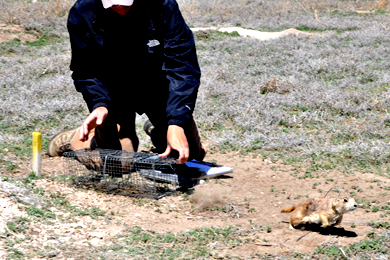Demography and dispersal of black-tailed prairie dogs at four small cultural parks.
 Investigators:
Investigators:
Amanda Goldberg, M.S. Student
Dr. Jack Cully
Rachel Pigg
Project Supervisor:
Dr. Jack Cully
Cooperators:
National Park Service (See list of parks below)
Great Plains Cooperative Ecosystem Study Unit
Status:
Currently in the field finishing data collection
Location:
Fort Larned, Kansas
Scotts bluff, Nebraska
Bent's Old Fort, Colorado
Sand Creek National Massacre site, Colorado
Completion:
Field season ends August 2011
Final Report December 2011
Funding:
USGS NRPP Grant
Progress and Results:
This project is looking at demography, dispersal, and management of black-tailed prairie dogs at four small national parks. The third and final field season will end in August of 2011. Sand Creek National Massacre site is the only site that was not trapped after 2009 due to a plague epizootic which killed off the town and it is still currently unoccupied. We use the robust design with full heterogeneity in Program Mark, in conjunction with the delta method, to estimate apparent annual survival for adults. The analysis is run separately for each site. Fort Larned was the only park to show a difference between the sexes of 33% for males and 84% for females and was highest from spring of 2010 to spring of 2011. Scotts Bluff's highest estimated apparent annual survival rates were the same for both sexes at 38% from spring of 2010 to spring of 2011. Bent's Old Fort is quite a bit lower at 17% and was highest from the spring of 2009 to the spring of 2010. Over the course of three years, 171 radio collars have been attached to prairie dogs at all the sites. Both intracolony and intercolony dispersal from both males and females was documented. Lastly, the study will compare the visual count method described by Plumb et al. (2001) to mark-resight analysis in program MARK and mark-recapture using closed population models to help parks decide which methods are the most useful to measure their towns abundance. With this data the parks will be better equipped to assess their populations and choose the best management strategy to both maintain their colonies and lower the risk of the prairie dogs expanding onto private land.
Products:
Goldberg, Amanda (M.S. 2011; advisor Cully). Apparent survival, dispersal, and abundance of black-tailed prairie dogs. Kansas State University.
Cully, J., R. Pigg, and A. Goldberg. 2010. Sustainability of black-tailed prairie dogs at small culture parks of the western Great Plains. 22nd North American Prairie Conference, Cedar Falls, Iowa.
Goldberg, A., and J. F. Cully. Estimated Apparent Survival of Black-tailed Prairie Dogs at Four Small National Parks Using the Robust Design in Program MARK. American Society of Mammalogists Annual Meeting, Portland Oregon, June 24-28, 2011.
Goldberg, A., J. F. Cully. Apparent Survival of Black-tailed Prairie Dogs at Four Small National Parks Using the Robust Design in Program MARK. 72nd Midwest Fish and Wildlife Conference, Des Moines, Iowa, 4-7 December 4-7, 2011.
Pigg, RM, AR Goldberg, DE Biggins, JF Cully, Jr. 2013. Local scale movement of a highly social grassland mammal: insights from field observations. Biology Graduate Student Research Forum, Kansas State University, Manhattan, KS.